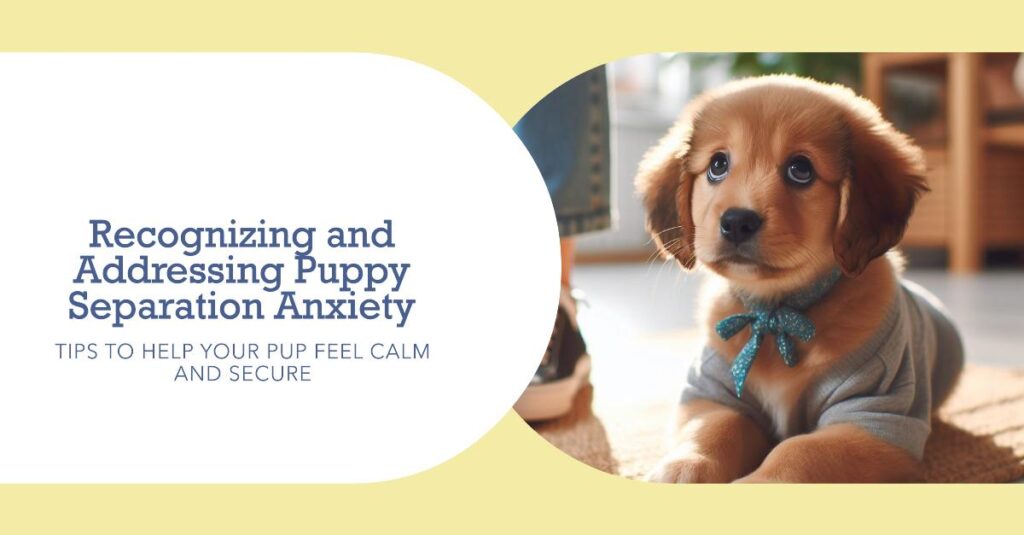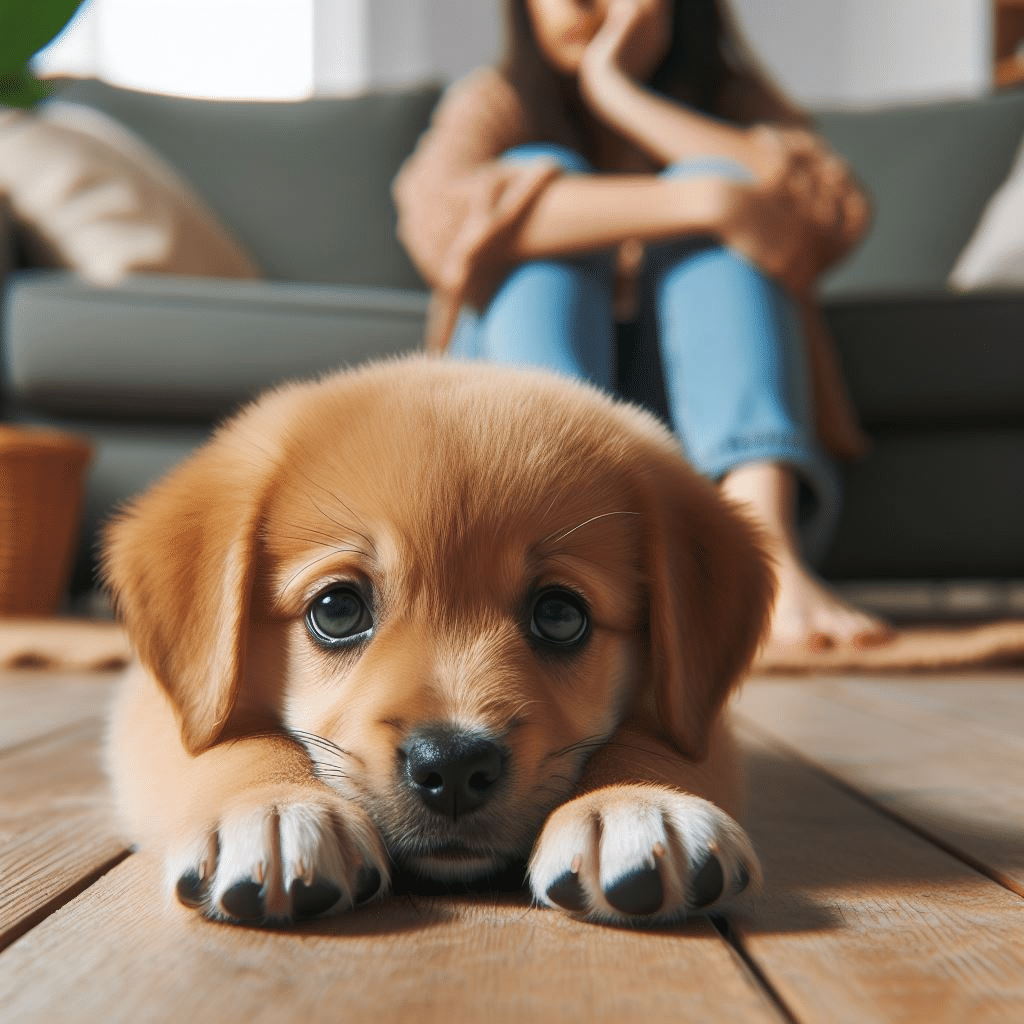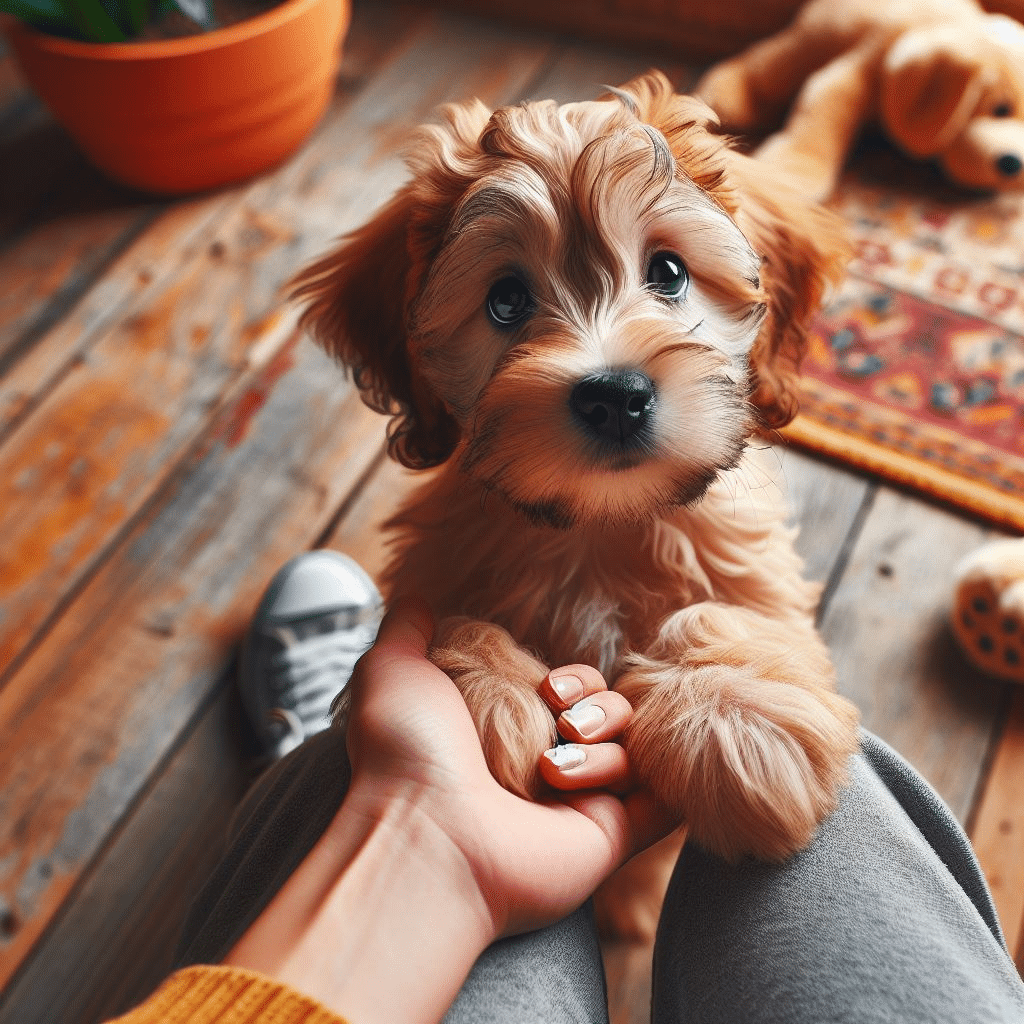Welcoming a new puppy into your life brings immeasurable joy but comes with challenges. One common issue is separation anxiety, which can be distressing for both you and your furry companion. Recognizing and addressing puppy separation anxiety is crucial for your dog’s emotional well-being and peace of mind. When puppies suffer from separation anxiety, they may exhibit destructive behaviors, incessant barking or whining, or even have accidents indoors due to stress.
Early identification and intervention are crucial to managing this condition. With patience, understanding, and the right strategies, you can help your puppy learn to feel safe and secure when left alone, leading to a happier and more harmonious life together. Rest assured that separation anxiety is manageable in most cases, and this comprehensive guide will equip you with the knowledge and tools needed to help your puppy cope.

Key Takeaways
- Separation anxiety is a genuine distress disorder in puppies, often caused by factors like lack of socialization, changes in routine, or breed predisposition.
- Recognizing the signs of separation anxiety, which include destructive behaviors, vocalization, elimination issues, and physical signs of stress, is crucial for early intervention.
- Prevention is the most effective approach and involves gradual desensitization training, starting with short absences and positive reinforcement.
- Creating a safe space with familiar scents and engaging distractions can significantly reduce anxiety for your puppy.
- Counterconditioning changes your puppy’s negative association with being alone by pairing it with positive experiences like special treats or playtime.
- Exercise, mental stimulation, and calming aids can provide additional support while addressing the underlying anxiety.
- Seek professional help from a veterinarian, behaviorist, or trainer if your puppy has severe symptoms, you’re not seeing progress, or safety is a concern.
Understanding Puppy Separation Anxiety
What are the signs of separation anxiety in puppies?
Separation anxiety in puppies goes beyond simply missing their human companions. It’s a genuine distress disorder that causes significant stress and can manifest in a variety of ways. Here’s a more in-depth look at the signs to watch for:
- Behavioral Signs
- Vocalization: Excessive barking, whining, or howling are classic signs. This vocalization might start as soon as you leave or even when you begin your departure routine (like putting on your shoes or picking up keys).
- Destructive behaviors: Separation anxiety can drive puppies to chew on furniture, doors, shoes, or other household items they wouldn’t usually touch. They may also scratch or dig at doors or windows in a frantic attempt to escape and reunite with you.
- Elimination issues: Separation anxiety can disrupt even a well-house-trained puppy’s habits, leading to accidents indoors.
- Pacing, restlessness, or inability to settle: Anxious puppies might pace back and forth, visibly struggle to relax, or appear constantly on edge.
- Changes in social behavior: Some puppies might become clingy or overly excited when you’re around, while others might seem withdrawn or depressed in your absence.
- Physical Signs
- Excessive panting or drooling can be signs of stress, even if the puppy isn’t in a hot environment.
- Trembling or shaking: Visible tremors or shaking clearly indicate fear and anxiety.
- Dilated pupils: A stressed puppy’s eyes might appear more expansive than usual.
- Changes in appetite: Anxiety might make them refuse food, eat less than usual, or, in some cases, overeat as a stress response.
- Self-harm: In severe cases, a puppy might resort to self-harming behaviors like excessive licking or chewing at their paws.
Important Considerations
- Not every case is the same: Puppies express anxiety in different ways. Some may show a few mild symptoms, while others might experience an intense combination of signs.
- Ruling out other causes: It’s essential to consult with your veterinarian to rule out any underlying medical issues contributing to some of these behaviors.
- The sooner, the better: Early recognition of separation anxiety allows for prompt intervention, increasing the chances of successfully managing the condition.

What causes separation anxiety in puppies?
There isn’t a single definitive cause of separation anxiety in puppies, but several factors can contribute to its development:
- Lack of Socialization: Puppies who haven’t had enough opportunities to socialize and learn to be comfortable on their own from a young age may be more prone to anxiety when left alone.
- Change in routine: Disruptions to a puppy’s familiar routine, such as a change in your work schedule, moving to a new home, or the introduction or loss of a family member (human or pet), can trigger separation anxiety.
- Traumatic experiences: A negative experience left alone, like a loud noise, a break-in, or a natural disaster, can cause a puppy to develop anxiety about being separated from their owners.
- Breed predisposition: Some dog breeds may be genetically predisposed to anxiety disorders, including separation anxiety. Breeds like German Shepherds, Labrador Retrievers, and Border Collies may be more likely to develop this condition.
- Medical Conditions: In some cases, underlying medical problems like cognitive dysfunction or hypothyroidism can manifest in behavioral changes and mimic the symptoms of separation anxiety.
A combination of these factors often leads to separation anxiety in a puppy. Understanding the potential causes is essential for developing an effective management and training plan.
Differentiating separation anxiety from boredom
While they may exhibit similar behaviors, it’s important to distinguish between genuine separation anxiety and boredom in a puppy. Here’s how to tell the difference:
| Characteristic | Separation Anxiety | Boredom |
| Onset | Behaviors are primarily triggered by your absence or signs that you’re about to leave. | Behaviors may occur randomly throughout the day. |
| Intensity | Symptoms are often severe and excessive (frantic destruction, loud and persistent vocalization, self-harm). | Behaviors tend to be milder (some chewing, occasional whining). |
| Focus | Anxious behaviors are often directed towards escape routes (doors, windows). | Bored behaviors often involve whatever is available (toys, furniture, etc.). |
| Consistency | Behaviors are typically consistent each time the puppy is left alone. | Behaviors may be sporadic depending on the level of boredom. |

Let’s break this down further:
- Separation Anxiety: This is a genuine fear response due to separation from their attachment figure (you).
- Boredom: This stems from a lack of mental and physical stimulation. While bored puppies can get destructive, it’s usually less intense.
Why it matters: Correctly identifying the root of the problem is critical to choosing the proper training and management strategies.
How to Calm a Puppy with Separation Anxiety
Prevention is key
The most effective approach to separation anxiety is prevention. Here’s how to help your puppy build positive associations with being alone from a young age:
- Gradual Desensitization: Start with short absences (a few seconds or minutes) and gradually increase the duration as your puppy becomes more comfortable. Practice leaving them with a fun chew or puzzle toy in their designated safe space.
- Departure and Arrival Rituals: Keep your greetings and departures low-key to reduce anticipation and excitement. Avoid making a fuss about leaving, and provide plenty of calm attention only when your puppy is relaxed.
Steps to Build Confidence:
- Choose a safe space: Set up a designated area for your puppy (like a comfy crate or room with a cozy bed) where they feel secure.
- Make it inviting: Scatter some treats in the area and let them explore at their own pace.
- Short absences: Leave your puppy in the safe space for brief periods, returning before they get anxious.
- Rewarded calm: While present, reward your puppy for calm and relaxed behavior in the area.
- Gradual increases: As they seem comfortable, extend your time away. Consider using a camera to observe how they react.
Creating a safe and comfortable environment
Providing your puppy with a haven can significantly reduce their anxiety when you’re not around. Here’s how:
- The Right Space: A crate can provide den-like security, especially with a comfy blanket and familiar scent. Alternatively, choose a cozy room where your puppy feels comfortable.
- Familiar Scents: Leave a piece of your clothing (like an old t-shirt) with your scent near their bedding. This can be surprisingly comforting.
- Calming Distractions: Provide engaging items like puzzle toys stuffed with treats or long-lasting chews to keep your puppy occupied and mentally stimulated.
- Background Noise: White noise, soft classical music, or even the familiar hum of a fan or TV can help mask potential noises that might startle your puppy.
Counterconditioning to change your puppy’s feelings about being alone
Counterconditioning and desensitization are the cornerstones of addressing separation anxiety. They aim to change your puppy’s negative emotional association with being alone into a positive one.
- The Principle: The idea is to pair being alone with something your puppy loves, like high-value treats, a super special toy, or playtime.
- How it Works: Each time you leave (even for short periods), provide your puppy with their special treat or toy. Immediately pick it up when you return. Over time, they’ll start to associate being alone with good things!
Step-by-Step Example
- Choose the reward: Identify something your puppy absolutely adores – a super tasty treat, a squeaky toy, or your undivided attention for a few minutes of play.
- Set up: Place your puppy in their safe space and give them the chosen reward.
- Build the association: Leave for very short periods (initially, a few seconds!), immediately return and take away the reward.
- Gradual Progress: Slowly increase the duration of your absences, rewarding them every time. Don’t rush! Moving too fast can cause a setback.
Important Note: If your puppy becomes visibly distressed during this process, shorten your time away and consult a professional dog behaviorist for further guidance.
Management Strategies for Puppy Separation Anxiety
The importance of exercise and mental stimulation
Physical exercise and mental stimulation are potent tools in managing separation anxiety for several reasons:
- Energy Release: A tired puppy is less likely to engage in anxious or destructive behaviors. Engage them in regular walks, playtime, and breed-appropriate activities.
- Stress Reduction: Exercise and play release natural endorphins, reducing anxiety and promoting a sense of calmness.
- Mental Challenge: Puzzle toys, training sessions, and learning new tricks keep your puppy’s mind engaged and prevent boredom.
Fun and Engaging Activities:
- Fetch or Frisbee: Classic games for high-energy pups.
- Agility or Scent work: Organized activities offer both mental and physical challenges.
- Interactive puzzle toys: Filled with treats or kibble, provide extended mental stimulation.
- Short training sessions: Work on basic commands or new tricks.
- Safe chew toys: Satisfy the urge to chew while also cleaning teeth.
Remember: A well-exercised and mentally engaged puppy can relax and feel content when alone.
Calming aids
While exercise and training are crucial, calming aids can provide additional support for your anxious puppy, especially in the initial stages of training.
- Natural calming supplements: Discuss options with your veterinarian. Look for ingredients like L-theanine, chamomile, or melatonin, which may promote relaxation.
- Pheromone diffusers or sprays: Products like Adaptil mimic a dog’s natural calming pheromones, creating a sense of security.
- Calming music: Specifically designed music with gentle rhythms and soothing tones can help some dogs relax.
Important Considerations:
- Always consult your veterinarian: They can help you determine if supplements are appropriate for your puppy and ensure no interactions with other medications.
- Don’t rely solely on aids: Calming aids should be used with training and management strategies for better results.
When to seek professional help
Recognizing when to step beyond at-home strategies and seek professional guidance is crucial to managing separation anxiety in puppies. Here’s a breakdown of when turning to experts is the suitable course of action:
- Severe Symptoms: If your puppy’s separation anxiety manifests in extreme behaviors, it’s time to call in professionals. These behaviors might include:
- Frantic attempts to escape: Your puppy might engage in excessive digging, chewing, or scratching at doors or windows, potentially causing damage to the house and, more importantly, putting themselves at risk of injury.
- Self-harm: Severely anxious puppies may resort to licking, chewing, or biting themselves to an extent that causes broken skin, bleeding, or hair loss.
- Uncontrollable elimination: Even a house-trained puppy might lose control of their bladder or bowels due to the overwhelming stress of separation.
- Intense and prolonged vocalization: Incessant barking, howling, or whining that goes beyond a reasonable amount and disrupts your or your neighbors’ lives.
- Lack of Progress: Dedication to training and management strategies is admirable, but sometimes more is needed. Suppose you’ve been consistently implementing a well-structured plan for a significant time but see no improvement or even worsening symptoms. In that case, it’s time for a new approach with professional help.
- Safety Concerns: Professional intervention is necessary if your puppy’s attempts to be reunited with you create hazardous situations. This includes jumping through windows, chewing electrical cords, or demonstrating an absolute inability to be confined safely.
Types of Professional Support
It’s essential to understand the different roles professionals can play in addressing severe separation anxiety:
- Veterinarian:
- Medical Rule-out: They’ll perform a thorough check-up to ensure no underlying medical conditions contribute to your puppy’s anxiety. Medical issues like cognitive decline, pain, or hormonal imbalances can manifest as anxiety-like behaviors.
- Medication: In severe cases where the puppy’s well-being is significantly compromised, your veterinarian might prescribe anti-anxiety medications alongside behavioral training to help manage the initial distress and increase the chances of success with a training plan.
- Certified Dog Behaviorist (CDBC):
- Root Cause Assessment: Behaviorists are experts at analyzing canine behavior. They’ll dig deep to identify the triggers and underlying reasons for your puppy’s separation anxiety.
- Personalized Training Plan: A behaviorist will tailor a step-by-step plan based on your puppy’s unique needs, using techniques like desensitization, counterconditioning, and positive reinforcement.
- Certified Professional Dog Trainer (CPDT):
- Guidance and Support: Trainers provide hands-on guidance in implementing the behavior modification plan created by a behaviorist (or your veterinarian). They’ll work with you on the practical skills and techniques needed for success.
- Consistency is Key: Trainers can help you remain consistent and on track with your training, a vital factor in overcoming separation anxiety.
Seeking professional support is not a sign of failure; it’s a proactive step toward providing the ultimate care for your beloved puppy. Addressing severe separation anxiety often requires a multi-pronged approach involving both behavioral and potential medical interventions for optimal results.
Additional Points to Consider
Patience and consistency are essential
Overcoming separation anxiety in puppies takes time and dedication. It’s essential to remain patient, avoid rushing the process, and celebrate even small progress. Consistency in your routines, training, and management techniques is crucial to your puppy’s success.
Avoid Punishment
Your puppy’s separation anxiety stems from fear and distress. Punishing them for anxious behaviors will only worsen the problem and damage your bond. Focus on positive reinforcement and rewarding calm, relaxed behavior.
Monitor progress
Keep a journal to track your puppy’s progress. Note down the duration of your absences, their anxiety levels, and any successful techniques. This will help you and any professional you may consult to identify patterns and adjust the training plan accordingly.
Conclusion
Separation anxiety in puppies can be a challenging issue, but it’s important to remember that it’s manageable in most cases. Understanding the signs, applying appropriate training and management techniques, and seeking professional help can teach your puppy to feel safe and secure when left alone.
Patience, consistency, and a positive approach are your most powerful tools in this journey. With dedication and the proper support, you can help your puppy overcome separation anxiety and build a happy, confident life by your side.
Resources for Further Help
- American Society for the Prevention of Cruelty to Animals (ASPCA): https://www.aspca.org/pet-care/dog-care/common-dog-behavior-issues/separation-anxiety
- International Association of Animal Behavior Consultants (IAABC): https://iaabc.org/ – Find a certified dog behavior consultant.
- Certification Council for Professional Dog Trainers (CCPDT): https://www.ccpdt.org/ – Find a certified professional dog trainer.
FAQs
Q: How can I tell if my puppy has separation anxiety?
A: Look for a combination of behaviors that occur primarily when you’re away or preparing to leave, such as destructive chewing, excessive vocalization, elimination of accidents indoors, or attempts to escape.
Q: Can a puppy outgrow separation anxiety?
A: Some puppies may experience mild separation anxiety that lessens with age and consistent exposure to short periods alone. However, actual separation anxiety often requires active training and intervention for improvement.
Q: How long does it take to fix separation anxiety in dogs?
A: The time it takes to manage separation anxiety varies depending on the severity, the dog’s age, and the consistency of the training plan. Significant improvement can take weeks or months.
Q: Will my puppy get separation anxiety if I work from home?
A: Puppies used to constant human companionship might be more prone to developing separation anxiety if their work situation changes. Even with a work-from-home schedule, prioritize short absences and independence training.
Q: Are there medications to help puppies with separation anxiety?
A: In severe cases, your veterinarian might recommend anti-anxiety medication and behavioral training to help your puppy cope while learning new skills.

